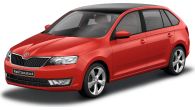It's a measure of the transformation of small cars in the last couple of decades that the new Hyundai i20 boasted features reserved for high-end luxury cars a tick over 20 years earlier. With a large number of buyers downsizing from the traditional larger models small cars have had to offer the sorts of things only their bigger cousins once did.
NEW
In the case of the i20 it was things like auto on-off headlamps and auto door locking, unthinkable in a 1990s model.The i20 was an attractive little hatch with pleasant styling and neat proportions with good all-round visibility. It was available as a three-door model that opened the range as well as a number of five-door models.
Inside it boasted comfortable accommodation for four with a boot of decent proportions to carry their gear. The range was made up of three models beginning with the Active, which was available as a three-door and a five-door hatch that had standard air-conditioning, remote central locking and fold-flat mirrors.
In the middle of the range was the Elite, which was only available as a five-door hatch, but added a trip computer, leather-wrapped steering wheel and alloy wheels to the list of features.
If you took another step up the range you arrived at the Premium five-door, which got you such previously undreamt of luxuries as automatic air, bigger alloy wheels and a smattering of leather trim.
Two engines were offered. The entry level Active was powered by a 1.4-litre engine that produced 73 kW and 136 Nm and delivered performance that was modest, but adequate for the class. Had you chosen the Elite mid-ranger you were given the choice of the 1.4-litre or a larger 1.6-litre engine that gave you the extra punch of 91 kW and 156 Nm.
All models offered the choice of five-speed manual and four-speed auto transmissions, and drive went through the front wheels.
NOW
After a rocky start in Australia when a serious chassis flaw in early Excels threatened to ground the brand for good Hyundai has had a largely trouble free run and has built an enviable reputation. Quality has improved markedly, reliability is on the up and the model offerings are more attractive.
It's mostly good news for the brand in general, which should give buyers confidence when out shopping for a used car. The i20 is one of the latest generation of models and is showing no signs of having any major flaws that should be of concern to potential used buyers.
There was one recall to replace a label on the jack, but that's a relatively minor issue that has no bearing on the car's reliability.
Something buyers need to be aware of is that the first Active cars to arrive here were only equipped with front airbags, which meant it was rated at four stars by ANCAP, but later models had a full complement of front and side airbags and was rated at five stars.
Importantly all had electronic stability control, as well as ABS brakes, traction control and electronic brakeforce distribution, all of which contributed to an impressive safety level. As with any used car purchase make sure your potential choice has been serviced as per Hyundai's recommendation.
SMITHY SAYS
Good value-for-money, solid performance, top safety and it's reliable, check it out.
Hyundai i20 - 2010-2012
Price new: $14,990 to $23,490
Engine: 1.4-litre 4-cylinder, 73 kW/136 Nm; 1.6-litre 4-cylinder, 91 kW/156 Nm
Transmission: 4-speed auto, 5-speed man, FWD
Economy: 6.0 L/100 km (1.4), 6.1 L/100 km (1.6)
Body: 3-door hatch, 5-door hatch
Variants: Active, Elite, Premium
Safety: 4/5-star ANCAP
Hyundai I20 2010: Active
| Engine Type | Inline 4, 1.4L |
|---|---|
| Fuel Type | Unleaded Petrol |
| Fuel Efficiency | 6.4L/100km (combined) |
| Seating | 5 |
| Price From | $4,840 - $7,150 |
| Safety Rating |
|
Pricing Guides





.jpg)

.jpg)












































.jpg)
Comments